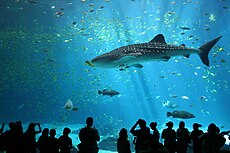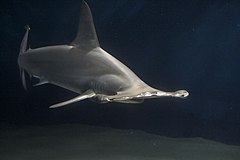
Dolphins are social, living in pods (also called "schools") of up to a dozen individuals. In places with a high abundance of food, pods can join temporarily, forming an aggregation called a superpod; such groupings may exceed a thousand dolphins. The individuals communicate using a variety of clicks, whistles and other vocalizations. They also use ultrasonic sounds for echolocation. Membership in pods is not rigid; interchange is common. However, the cetaceans can establish strong bonds between each other. This leads to them staying with injured or ill individuals, even actively helping them to breathe by bringing them to the surface if needed.[16] This altruistic behaviour does not appear to be limited to their own species however. A dolphin in New Zealand that goes by the name of Moko has been observed to seemingly help guide a female Pygmy Sperm Whale together with her calf out of shallow water where they had stranded several times.[17] They have also been known to seemingly protect swimmers from sharks by swimming circles around the swimmers[18][19] or charging the sharks to make them go away.[citation needed]

Dolphins are often regarded as one of Earth's most intelligent animals, though it is hard to say just how intelligent dolphins are, as comparisons of species' relative intelligence are complicated by differences in sensory apparatus, response modes, and nature of cognition. Furthermore, the difficulty and expense of doing experimental work with large aquatics means that some tests which could yield meaningful results still have not been carried out, or have been carried out with inadequate sample size and methodology. Compared to many other species however, dolphin behaviour has been studied extensively by humans, both in captivity and in the wild. See the cetacean intelligence article for more details.

In 1933, three strange dolphins were beached off the Irish coast; these appeared to be hybrids between Risso's Dolphin and the Bottlenose Dolphin.[3] This mating has since been repeated in captivity and a hybrid calf was born. In captivity, a Bottlenose Dolphin and a Rough-toothed Dolphin produced hybrid offspring.[4] A Common-Bottlenose hybrid lives at SeaWorld California [5] Various other dolphin hybrids live in captivity around the world or have been reported in the wild, such as a Bottlenose-Atlantic Spotted hybrid.[6] The best known hybrid however is the Wolphin, a False Killer Whale-Bottlenose Dolphin hybrid. The Wolphin is a fertile hybrid, and two such Wolphins currently live at the Sea Life Park in Hawaii, the first having been born in 1985 from a male False Killer Whale and a female Bottlenose. Wolphins have also been observed in the wild.[7]

Dolphins are marine mammals that are closely related to whales and porpoises. There are almost forty species of dolphin in seventeen genera. They vary in size from 1.2 m (4 ft) and 40 kg (90 lb) (Maui's Dolphin), up to 9.5 m (30 ft) and 10 tonnes (9.8 LT; 11 ST) (the Orca or Killer Whale). They are found worldwide, mostly in the shallower seas of the continental shelves, and are carnivores, mostly eating fish and squid. The family Delphinidae is the largest in the Cetacea, and relatively recent: dolphins evolved about ten million years ago, during the Miocene. Dolphins are considered to be amongst the most intelligent of animals and their often friendly appearance and seemingly playful attitude have made them popular in human culture.

Until recently only a few benthic species of shark, such as hornsharks, leopard sharks and catsharks had survived in aquarium conditions for up to a year or more. This gave rise to the belief that sharks, as well as being difficult to capture and transport, were difficult to care for. A better knowledge of sharks has led to more species (including the large pelagic sharks) being able to be kept for far longer. At the same time, transportation techniques have improved and long distance movement of sharks is becoming easier.[54] One shark that never had been successfully held in captivity for long was the great white. But in September 2004 the Monterey Bay Aquarium successfully kept a young female great white shark for 198 days before releasing her back into the wild.
Most species of shark are not suitable for domestic aquaria and not every species of shark sold by pet stores make good inhabitants for personal aquaria. Some species of sharks can also be kept well in home saltwater aquaria.[55] Uninformed or unscrupulous dealers sometimes sell juvenile sharks like the nurse shark, which upon reaching adulthood will have far outgrown typical home aquaria.[55] Public aquaria are generally not interested in accepting donated specimens that have overgrown their housing and some shark owners have been tempted to release them into the wild.[55] Species appropriate to home aquaria represent considerable spatial and financial investments as they generally approach adult lengths of 3 feet and can live up to 25 years.[55]

All sharks are carnivorous and many people believe that sharks will eat just about anything; for a few species, such as the tiger shark, this is true. The vast majority of sharks, however, are far more specialised for particular prey items, and rarely stray from these. Some of the most specialised sharks have developed a filter feeding technique, which is employed by the whale, basking and megamouth sharks. These three shark species have evolved plankton feeding independently and use different strategies. Whale sharks feed using suction to take in large concentrations of plankton and small fishes. Basking sharks are ram-feeders, swimming steadily, with their mouth wide open, through plankton blooms. Megamouth sharks may make their suction feeding extra efficient with the use of luminescent tissue inside the mouth the attract prey in the deep ocean. This type of feeding was only possible through the evolution of gill rakers, long slender filaments that form a very efficient sieve, analogous to the baleen plates of the great whales. Plankton is trapped in these filaments and swallowed from time to time in huge mouthfuls. Teeth in these species are very small compared to the size of the animal, because they are not needed for feeding.

Sharks have keen olfactory senses, located in the short duct (which is not fused, unlike bony fish) between the anterior and posterior nasal openings, with some species able to detect as little as one part per million of blood in seawater. They are more attracted to the chemicals found in the guts of many species, and as a result often linger near or in sewage outfalls. Some species, such as nurse sharks, have external barbels that greatly increase their ability to sense prey.
Sharks generally rely on their superior sense of smell to find prey, but at closer range they also use the lateral lines running along their sides to sense movement in the water, and also employ special sensory pores on their heads (Ampullae of Lorenzini) to detect electrical fields created by prey and the ambient electric fields of the ocean.